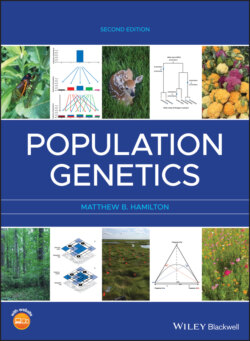Читать книгу Population Genetics - Matthew B. Hamilton - Страница 39
Box 2.3 Locating relatives using genetic genealogy methods
ОглавлениеGenetic genealogy is the use of DNA testing to augment historical records with the goal of identifying ancestors and descendants. The approach is to use autosomal, Y‐chromosome, and mitochondrial DNA genetic markers to locate relatives based on observed sharing of alleles and haplotypes. With enough genetic loci, even distant relatives who have small coancestry coefficients can be identified if their genotypes are available for comparison. Genetic profile data has been collected for millions of individuals who have participated in direct‐to‐consumer DNA testing. Applications include reconstruction of family histories, identification of ancestral population origins, and identifying the biological parents of adoptees.
Genetic genealogy or familial searching methods are used to identify suspects in unsolved serial violent crimes. While DNA profiles can be used as evidence to link a known suspect to a crime, direct identification of an unknown suspect is impossible if that person's DNA profile is not already present in a forensic or offender genetic database. A recent innovation is to use DNA profiles obtained from crime scenes to identify the relatives of suspects through searches in genetic genealogy databases. This approach initially utilized public databases to search for relatives and led to numerous cold cases being solved. At the same time, law enforcement and other uses of genealogical databases have generated concern over the privacy of genetic information.
(2.23)
With consanguineous mating, the decline in realized heterozygosity (substituting H for freq[Aa]) in the progeny is proportional to the coancestry coefficient which gives the probability that alleles identical in state are inherited because of relatedness among parents, shown by substituting He for 2pq in Eq. 2.20 and rearranging to give
(2.24)
where He is the Hardy–Weinberg expected heterozygosity based on population allele frequencies. Rearranging Eq. 2.21 in terms of the autozygosity gives
(2.25)
This is really exactly the same quantity as the fixation index (Eq. 2.9)
(2.26)
With the understanding that we are considering only a single generation of mating and that the population initially had Hardy–Weinberg expected genotype frequencies, we see that the fixation index measures an excess of homozygosity exactly equal to the autozygosity. Sustained non‐random mating over multiple generations will continue to increase the homozygosity, and therefore, F will reflect the cumulative deficit of heterozygosity from all past mating among relatives. In contrast, f is defined on a per generation basis and reflects only the probability of identity by descent at mating in the most recent generation. This distinction can be observed in Figure 2.13 where F increases over time toward an equilibrium as a function of the coancestry coefficient due to each mating system.
We can also use the fixation index in Eq. 2.23 rather than the autozygosity to express deviations from Hardy–Weinberg expected genotype frequencies due to accumulated autozygosity caused by mating patterns such as freq(AA) = p2 + Fpq and freq(Aa) = 2pq − F2pq where F2pq is the amount of heterozygosity missing from (or added to) the Hardy–Weinberg expected heterozygote frequency with half of that total or Fpq being added to (or subtracted from) each of the homozygotes. It is important to note that this time F represents the correlation of allelic state within genotypes from all causes accumulated over time that alters genotype frequencies from their Hardy–Weinberg expected values. While the difference in notation between F and f seems minor, their biological interpretations differ substantially in this example.
Returning to Figure 2.13 reinforces the relationship of the coancestry coefficient, the fixation index, and the decline in heterozygosity in several specific cases of regular consanguineous mating. Remember that in all cases in Figure 2.13, the Hardy–Weinberg expected heterozygosity is 0.5 when mating is random and f = 0.
